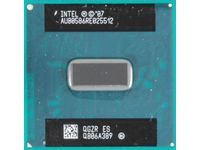Efficiency: Core 2 Nukes Atom On The Desktop
Atom or Core 2?
Intel Atom 230 (1.6 GHz Single Core)

The Atom 230 processor is a 26 mm², 45 nm, single-core device that utilizes the same front side bus (FSB) as the Core 2 processor family. However, it doesn’t employ Socket 775, but has a 22x22 mm 437-ball micro FCBGA package that Intel decided to pair with the 945GC chipset, which is a 945G chipset with support for FSB1066 and DDR2-667. It is thus limited to FSB800 (Atom utilizes FSB533) and DDR2-533 memory.
Atom supports Intel’s Hyper-Threading technology, offering thread-level parallelism so that one physical processor core serves as two logical cores for software that takes advantage of the feature. Indeed, Hyper-Threading has proven valuable as it boosts system responsiveness and offers slight performance increases. As already mentioned above, the Atom 230 is rated at a thermal design power (TDP) of only 4 W despite its 1.6 GHz clock speed. Intel’s most powerful tool for maintaining this low power level despite the Atom’s 512 KB L2 cache and 47 million transistors is the 45 nm high-k silicon manufacturing process, which ensures low leakage currents.
The platform remains the real issue–while the processor is highly power-optimized, the chipset still is based on the same, three-year old 945 design. This is an advantage when it comes to implementation and compatibility, as 945 still includes UltraATA controllers, for example. But it’s a huge disadvantage when it comes to total system power—a 4 W TDP processor combined with a 22.2 W TDP platform (total TDP rated at 29.5 W) doesn’t match up well.
There also is a dual-core Atom 330 processor available in retail channels that is rated at 8 W TDP at the same 1.6 GHz clock speed. We didn’t have a suitable platform available at the time we finalized this review, but we will follow up on Atom dual-core performance. While we expect it to increase the performance-per-watt benchmarks for a number of desktop applications, it still isn’t even capable of beating a current Celeron processor.


Intel Core 2 Duo E7200 (2.53 GHz Dual Core)

Core 2 Duo was launched July 2006 and was manufacturing using Intel’s 65 nm process at the time. Intel then improved the device’s features and scaled its size down as well with a 45 nm process in February 2008. The first models were called E4000 and E6000, with 2 MB and 4 MB L2 cache, respectively, and clock speeds of up to 3.0 GHz. All current models are called E7000 and E8000, have 3 MB and 6 MB L2 cache, respectively, and offer performance-per-watt improvements. The E8600 top model runs at 3.33 GHz and is the best version for performance and overclocking, but we found the E7000 particularly interesting in terms of performance per watt.
Stay on the Cutting Edge
Join the experts who read Tom's Hardware for the inside track on enthusiast PC tech news — and have for over 25 years. We'll send breaking news and in-depth reviews of CPUs, GPUs, AI, maker hardware and more straight to your inbox.
Although they’re based on the same high-end 45 nm process, Core 2 processors carry hundreds of millions of transistors and consequently consume a lot more power than the Atom does–but they also deliver several times more performance. The question is: Can we create a Core 2 Duo system that offers the low system idle power of an Atom 230 system? This would result in a desktop PC with exceptionally low power requirements and performance that is well capable of handling more demanding applications.


Comparison Table
| Row 0 - Cell 0 | Intel | Intel |
| Name | Atom 230 | Core 2 Duo |
| Clock Speed | 1600 MHz | 2533 MHz |
| Code Name | Diamondville | Wolfdale |
| Based on | x86-64 | x86-64 |
| Cores | 1 | 2 |
| L1 Cache | 32+24 KB Data/Instruction Cache | 32+32 KB Data/Instruction Cache |
| L2 Cache | 512 KB | 3 MB |
| Interface | FSB800 | FSB800 |
| Hyper-Threading | Yes | No |
| Instruction Sets | MMX, SSE, SSE2, SSE3, SSSE3 | MMX, SSE, SSE2, SSE3, SSSE3, SSE4.1, TXT |
| Buffer Overflow Protection | XD bit | XD bit |
| On-Die Encryption | No | No |
| Die size | 26 mm² | 81 mm² |
| Transistors | 47 million | 274 million |
| Package | 22x22 mm, 441-ball Micro-FCBGA | Flip-Chip Land Grid Array (FC-LGA6), LGA775 |
| Process Technology | 45 nm | 45 nm |
| TDP | 4 W | 65 W |
Current page: Atom or Core 2?
Prev Page Atom Just Isn’t For Desktops Next Page Intel Atom: ECS 945GCT-DMost Popular

